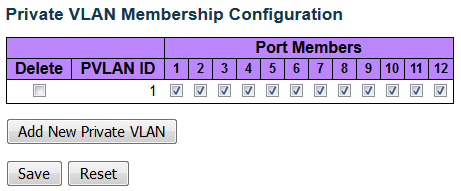Private VLAN Membership
The Private VLAN membership configurations for the switch can be monitored and modified here. Private VLANs can be added or deleted here. Port members of each Private VLAN can be added or removed here.
Private VLANs are based on the source port mask, and there are no connections to VLANs. This means that VLAN IDs and Private VLAN IDs can be identical.
A port must be a member of both a VLAN and a Private VLAN to be able to forward packets. By default, all ports are VLAN unaware and members of VLAN 1 and Private VLAN 1.
A VLAN unaware port can only be a member of one VLAN, but it can be a member of multiple Private VLANs.

| Object | Description |
|---|---|
| Delete | To delete a private VLAN entry, check this box. The entry will be deleted during the next save. |
| PVLAN ID | Indicates the ID of this particular private VLAN. |
| Port Members | A row of check boxes for each port is displayed for each private VLAN ID. To include a port in a Private VLAN, check the box. To remove or exclude the port from the Private VLAN, make sure the box is unchecked. By default, no ports are members, and all boxes are unchecked. |
| Add New Private VLAN button | Click to add a new private VLAN ID. An empty row is
added to the table, and the private VLAN can be configured as needed. The
allowed range for a private VLAN ID is the same as the switch port number
range. Any values outside this range are not accepted, and a warning message
appears. Click OK to discard the incorrect entry or click Cancel to return to the editing and make a correction. The Private VLAN is enabled when you click Save. The button can also be used to undo the addition of new Private VLANs. |
| Buttons | |
|---|---|
 |
Refresh the page immediately. |
 |
Add a new private VLAN ID. |
 |
Save changes. |
 |
Undo any changes and revert to previously saved values. |

